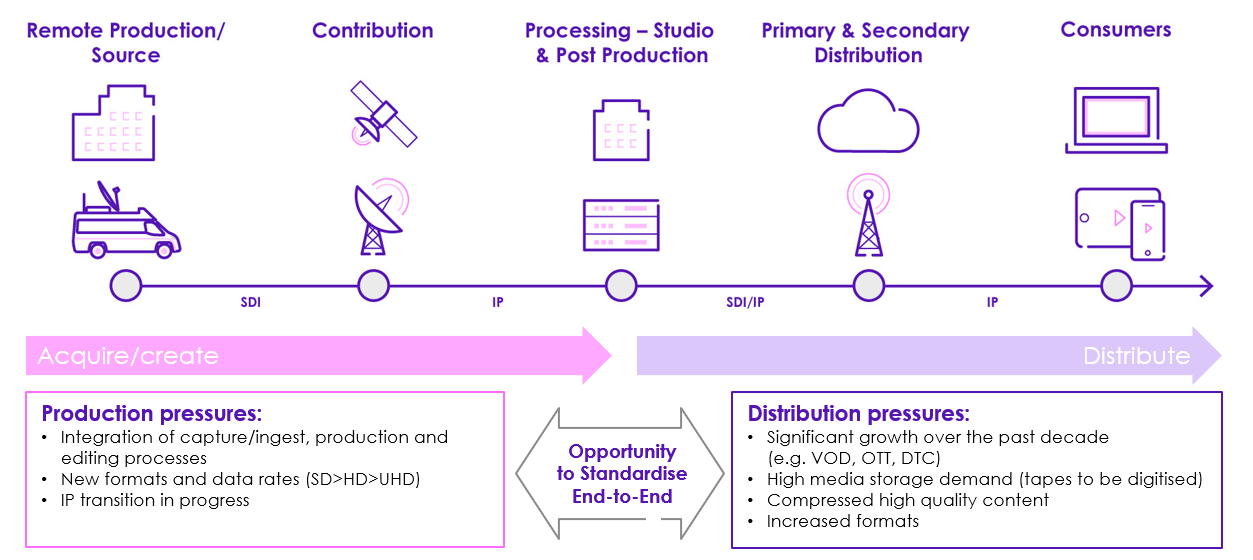NEWS
Transition to all IP
The current situation in the world due to COVID-19 has made the media industry realise the importance of having an IP-based platform to continue to connect to their users and provide rich content.
Driven by changing viewer habits, the demand for more content, and the desire to be less reliant on increasingly scarce satellite spectrum, the industry – and specifically broadcasters – are being pushed to deploy IP technology whilst being challenged by technical complexities and budget constraints. However, transitioning to IP is still everyone’s number one concern. The major challenges are content security, piracy, reducing broadcast latency, and implementing cloud technology.
The barriers to IP are coming down
A decade ago, companies were reluctant to be early adopters of Cloud and didn’t want to move their content into a virtualised environment. Mainly due to concerns around security, lack of infrastructure and knowledge, huge cost for transition etc. Similarly, the transition to IP was, and is still considered a huge investment especially when you have legacy infrastructure and it’s not part of your vision and strategy. However, in the past few years with more and more users consuming content through online platforms, more subsea/terrestrial cables being laid across the globe connecting continents, and new standards and protocols such as HEVC and SMPTE 2110 improving video/audio workflows, broadcast professionals are now planning to make that shift to IP.
Satellite continues to be the prime medium to carry content from one destination to the other, especially in hard to reach geographical locations where fibre presence is still prohibited due to cost.
With the investments and infrastructure now available to do cloud-based playout, remote production, storage in the cloud, and software defined networks, there is more reason to move to IP. Looking at the below map, it is clear that the reach of IP is so significant that one shouldn’t miss an opportunity to connect to the user.
We are now at a stage where I can just say “meet me at this address in the cloud environment and you can access my content both from a linear and non-linear perspective”

IP powers up remote production
There are great benefits of having an all-IP infrastructure and the possibilities are endless when it comes to remote production if your setup is IP-ready.
Remote production is the ability to produce live broadcasts at a distance from the actual event, by transmitting raw (ISO) feeds, audio, and equipment control over telecoms infrastructure to a studio facility (either centralised or decentralised), from where you have the possibility to remotely control cameras and other equipment at the event site. Now imagine the telecoms infrastructure is IP ready, supporting bandwidth as high as 100Gb+ to enable uncompressed video, a platform which is integrated with the Internet allowing remote editing & insertion of graphics, setting the bedrock for enabling a true remote production.

Migration to IP gives broadcasters the opportunity to standardise production infrastructure from end to end which saves money on supporting multiple platforms and formats and allows broadcasters to take advantage of mass-market priced IT infrastructure. However, this then leads to one of the most talked about topics while transitioning to IP that is SECURITY. How secure is my content and what measures are put in place to ensure I am not compromised?
Content creators need cyber security
For content creators and owners who further distribute content to a broadcaster via IP, it is important that the network is private and dedicated for them and the right security measures are put in place. A lack of cyber security measures or poorly deployed solutions can lead to compromised content, shutdown of infrastructures and risks a brand’s reputation.
It’s critical that cyber security gets a seat in the planning stage and not when the infrastructure is built. Even DDoS is a common threat to media companies and sports organisations who are putting more content on their website and in the cloud. It is important these companies collaborate with service providers who offer security measures as part of their IP network.
Creativity connected. Content assured.


